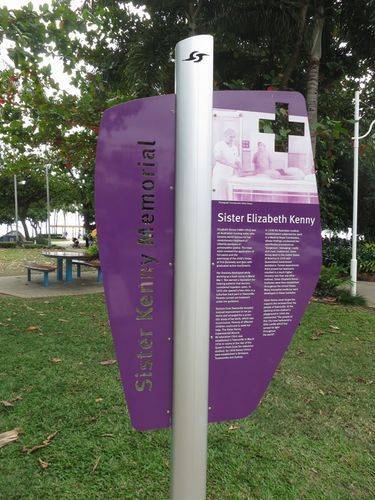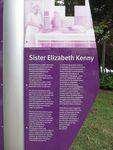
Sister Elizabeth KennyPrint Page 
The monument commemorates Elizabeth Kenny (1880 - 1952) who was an Australian nursing sister who became world famous for her revolutionary treatment of infantile paralysis or poliomyelitis (polio).
Her treatment involved the application of hot packs, and the exercising of the children`s limbs, at first passively and then with graduated active movements. Her theories were developed while working as a bush nurse and during her service as a nurse in World War One. She earned a reputation for helping patients that doctors considered hopeless cases.
Location
| Address: | The Strand, Townsville, 4810 |
|---|---|
| State: | QLD |
| Area: | AUS |
| GPS Coordinates: | Lat: -19.2525 Long: 146.818611 Note: GPS Coordinates are approximate. |
Details
| Monument Type: | Monument |
|---|---|
| Monument Theme: | People |
| Sub-Theme: | Medicine |
Dedication
Sister Kenny Memorial
Sister Elizabeth Kenny
Elizabeth Kenny (1880 - 1952) was an Australian nursing sister who became famous for her revolutionary treatment of infantile paralysis of poliomyelitis (polio). The treatment involved the application of hot packs and the exercising of the child`s limbs, at first passively then with graduated active movements.
Her theories developed while working as a bush nurse in World War I. She earned a reputation for helping patients that doctors considered hopeless cases. In 1933 she opened a free clinic in a suburban back yard in Townsville. Parents carried out treatment under her guidance.
Doctors from Townsville Hospital noticed improvement in her patients and arranged for a scientific study of her work, which was inconclusive. Parents of affected children continued to seek her help. The Sister Kenny Experimental Muscle Re-education Clinic was established in Townsville in March 1934 in rooms at the rear of the Queen`s Hotel (now Ten television studies). By 1936 Kenny Clinics were established in Brisbane, Toowoomba and Sydney.
In 1938 the Australian medical establishment subjected her work to a Medical Royal Commission, whose findings condemned her unorthodox procedures as `dangerous`, `damaging`, costly and cruel. Undeterred, Sister Kenny went to the United States to America in 1939 with Queensland Government assistance. Formal experiments there proved her teatments resulted in a much higher recovery rate than any other method. Sister Elizabeth Kenny Institutes were then established throughout the United States. Many innovative medicine were developed in these institutes.
Sister Kenny never forgot the support she received from the people of Townsville. At the opening of the children`s playground in 1949 she commented "the people of this city have harboured a little candle which has spread its light throughout the world".






